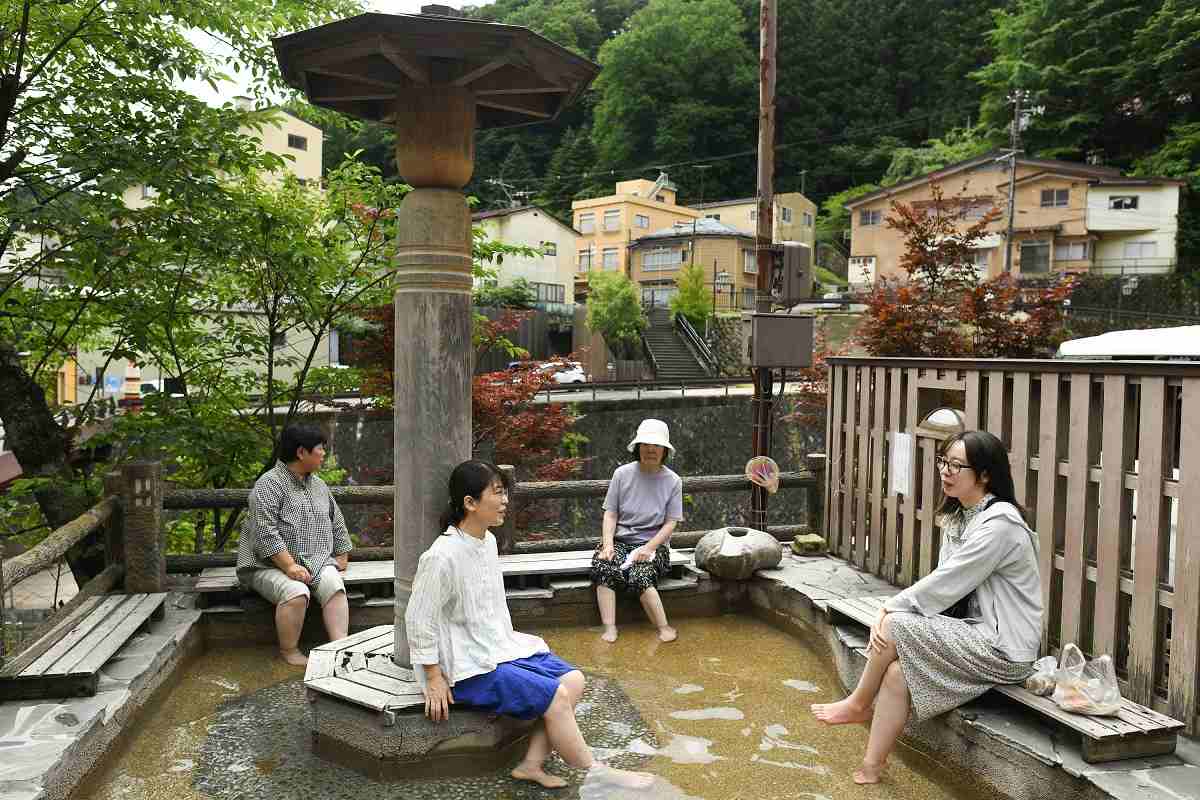
Visitors experience a foot bath at a Tsuchiyu Onsen hot spring.
14:20 JST, September 2, 2024
TSUCHIYU ONSEN, Japan – For 1,400 years, travelers have come to this town in the foothills of the Azuma Mountains, on the outskirts of Fukushima City, to bathe in the famed healing waters of its hot springs.
Through the centuries, residents have depended on this water to bring visitors to their inns, bath houses and souvenir shops. But nine years ago, local leaders took a risk that few other hot spring towns in Japan were willing to accept: They built a geothermal power plant to turn their precious hot spring water into a source of renewable electricity.
Now, Tsuchiyu Onsen is a test case for how Japan could tap into an abundant source of clean power while preserving the country’s cultural identity. Japan has the world’s third-biggest geothermal energy reserves, but it depends on imported fossil fuels for most of its electricity. Experts say geothermal could provide about 10 percent of the country’s power, if Japan took advantage of it. The government plans to triple geothermal energy output this decade, from 0.3 percent of electricity production to 1 percent.
But one of the biggest barriers has been opposition from Japan’s hot spring industry. Most of Japan’s geothermal energy reserves lie near one of the country’s more than 3,000 hot springs, called onsens, that play an important role in Japanese culture and tourism. The owners of inns and bathhouses worry that geothermal development could damage their source of spring water, devastating their businesses.
But here, residents say they’ve found a way for power plants and onsens to coexist.
“It’s really important to preserve the Japanese culture of onsen and the identity that is so important to Japan, so that needs to be protected at all costs,” said Rio Watanabe, the 22nd-generation owner of the Sansuiso Hotel in Tsuchiyu Onsen. “But we also need to start promoting clean energy as Japan, so we need to think about creating a new identity.”
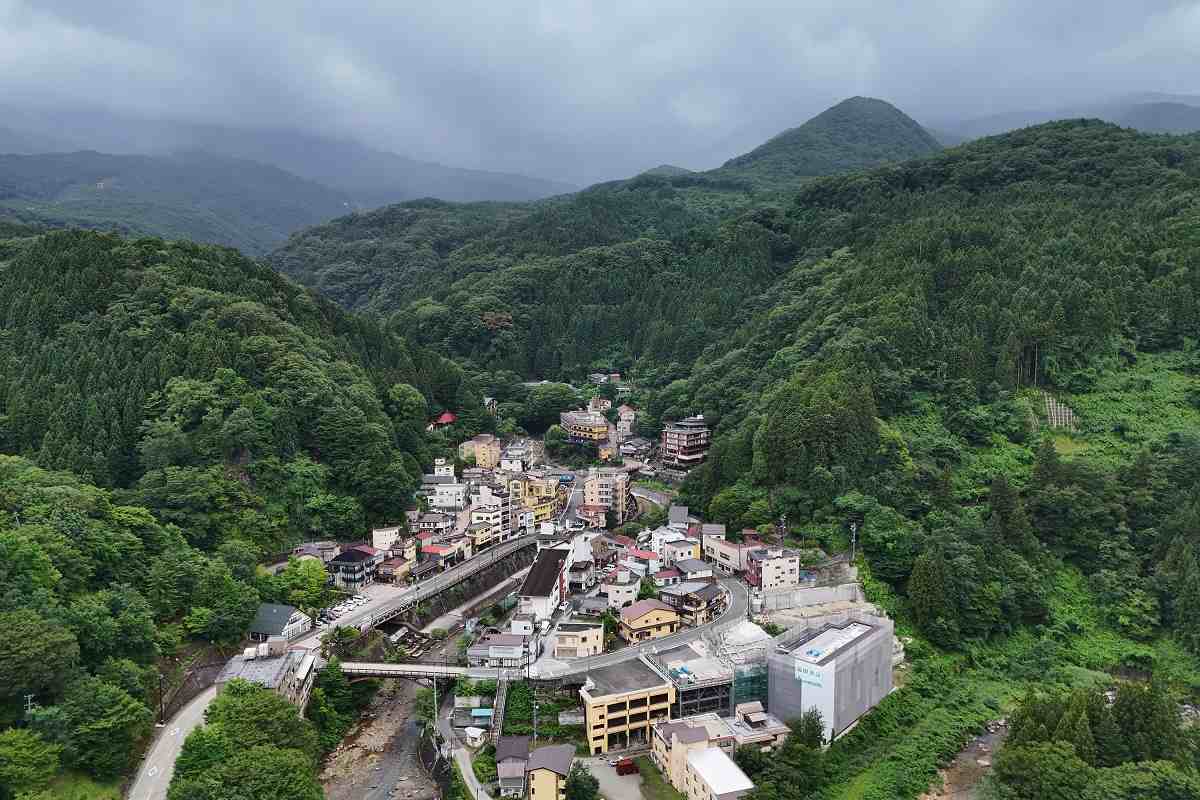
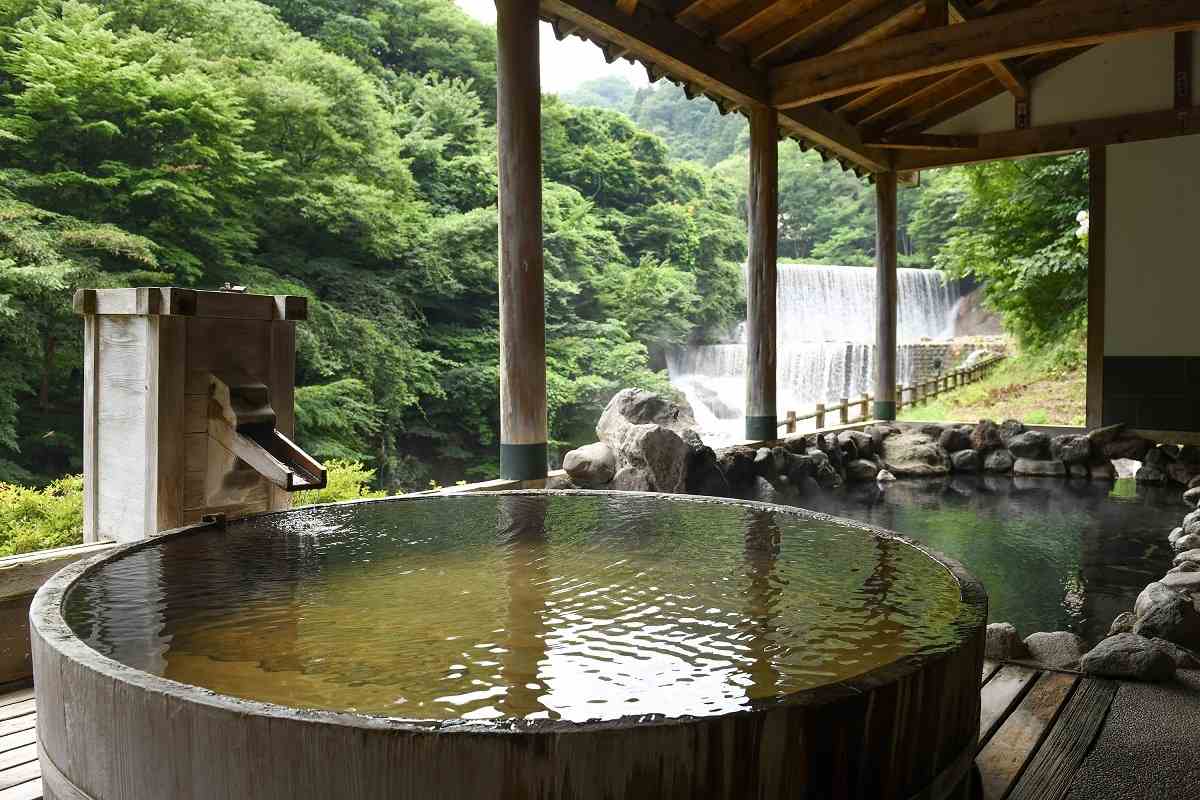
Left: Tsuchiyu Onsen, a nature-rich hot spring town surrounded by the mountains is home to many ryokan and hotels in the Fukushima Prefecture, Japan.
Right: Hot spring water running out from a wooden tap at Sansuiso Hotel in Tsuchiyu Onsen.
The power plant next to the spa
Tsuchiyu Onsen residents put aside their misgivings about geothermal development after the 2011 Fukushima nuclear disaster that devastated the local economy and prompted Japan to shift away from nuclear energy.
Hiroko Abe, 81, remembers the moment on March 11, 2011, when a 9.1-magnitude earthquake shifted the ground beneath her feet. Abe runs a shop that sells traditional wooden dolls and other souvenirs to hot spring visitors. At 2:46 p.m. the earth shook for six minutes, and all around her, merchandise clattered off the shelves.
Roughly 40 miles away, a 40-foot tsunami triggered a meltdown at the Fukushima Daiichi Nuclear Power Plant, forcing more than 150,000 people to evacuate. Some of them fled to Tsuchiyu Onsen. For nearly a year, the town was full of evacuees staying at local inns until they could return home. Then they trickled away – but the usual tourists didn’t return.
“Everything closed after the earthquake,” Abe said. “It wasn’t because of the physical damage so much as the rumors about the nuclear plant and radiation. People stopped coming to Fukushima.”
Business tanked. Five of the town’s 16 inns shut down. Local leaders looked for any idea that might raise money, attract visitors and save Tsuchiyu Onsen from oblivion.
Meanwhile, Japan temporarily shut down all of its nuclear reactors, which had provided nearly a third of the country’s electricity and were the cornerstone of its clean power plan. Instead, energy regulators decided to focus on expanding wind, solar and geothermal power.
So, in 2015, Tsuchiyu Onsen developed a geothermal plant – one of the first built under a looser set of environmental regulations the Japanese government created after the earthquake. It was the first built in a Japanese national park.
Throughout most of the country, the onsen industry is united in opposing geothermal development, saying they fear big drilling projects will damage their source of spring water, wrecking their businesses and threatening an age-old cultural tradition.
“We don’t intend to oppose geothermal energy for the sake of opposition, but we are concerned that there are currently no legal protections or relief measures in place for the onsens,” said Yoshiyasu Sato, vice president of the Japan Onsen Association. “We want to make sure the government is prepared to compensate if there is actual damage or a drop in temperature or water levels.”
Sato points to the example of the Takanoyu Onsen inn, which had to close temporarily after 135 years in business because its water temperature dropped a year after a big geothermal plant opened nearby in 2019. He acknowledged that there’s no evidence linking the temperature change to the geothermal plant, but he said the news rattled the onsen industry.
But in Tsuchiyu Onsen, the families that own inns and bathhouses worked with the local tourism association to found an energy company, Genki Up Tsuchiyu, to build a plant with their own money.
“The community bonded together to shift from nuclear energy to a source of energy that seemed safer,” said Watanabe, whose family has operated inns in Tsuchiyu Onsen for more than three centuries. “If it wasn’t for the nuclear meltdown, things might not have gone so smoothly. There may have been more opposition.”
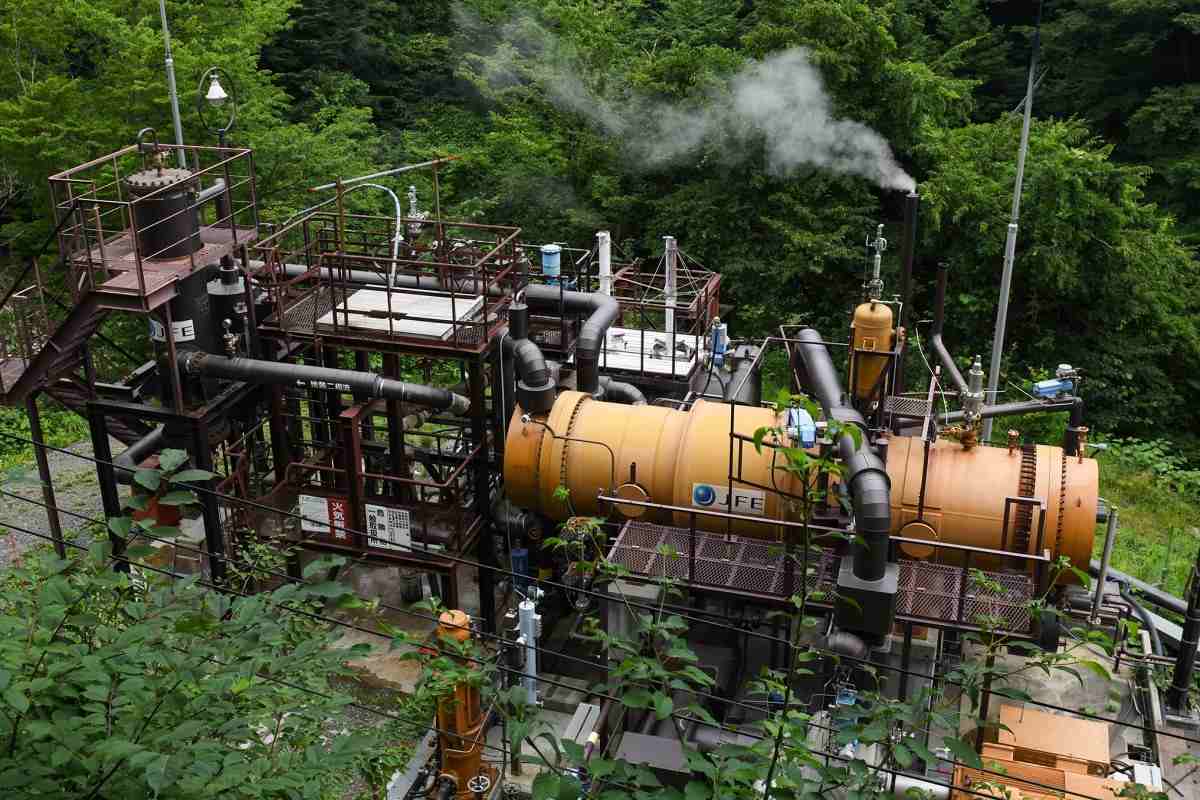
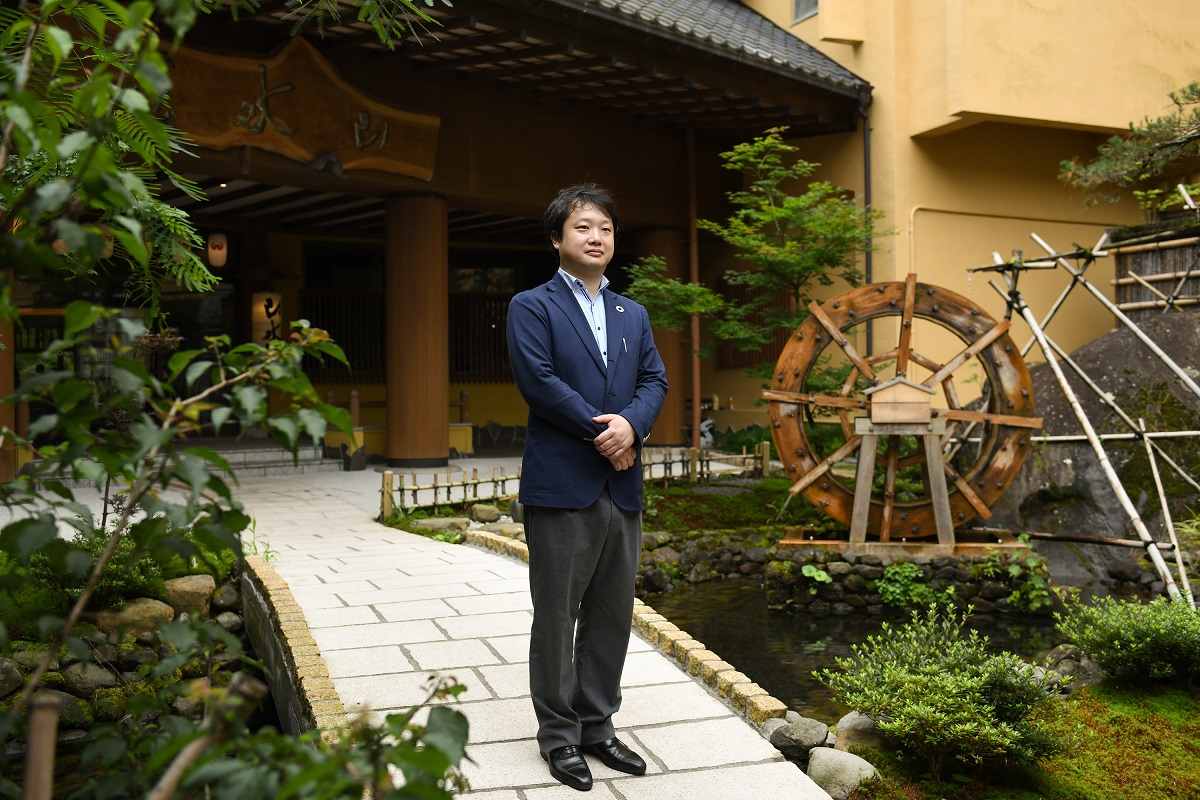
Left: A geothermal plant in Tsuchiyu Onsen.
Right: Rio Watanabe, the 22nd-generation owner of the Sansuiso Hotel in Tsuchiyu Onsen.
The promise of small plants
Tsuchiyu Onsen’s geothermal plant, which opened in 2015, is tiny compared to the nuclear reactors that Japan shut down in the wake of the 2011 earthquake, or the oil, coal and natural gas furnaces that still provide two-thirds of Japan’s electricity.
The Fukushima Daiichi nuclear plant once generated 4.7 gigawatts of electricity, powering millions of homes and businesses. The Tsuchiyu Onsen geothermal plant generates 400 kilowatts of electricity, which Genki Up Tsuchiyu says is enough to power about 800 homes and provide warm water for a nearby shrimp farm.
Small plants like this one are unlikely to change the face of Japanese energy production on their own, according to Kolbrún Ragna Ragnarsdóttir, who analyzes geothermal energy at the International Renewable Energy Agency, an intergovernmental organization that represents 168 countries. But they can play an important role in getting people to understand and accept geothermal power – and pave the way for bigger plants in the future, she said.
“This helps to [convince] local communities all over Japan, hopefully, that they can build something like this and they will not destroy their natural, beautiful environment,” she said.
Japan’s volcanic islands rest on thousands of shallow pockets of underground heat radiating up from molten rocks. When groundwater flows into these hot spots, it shoots to the surface as steam – creating the perfect conditions for both hot spring baths and geothermal energy. Japan’s government estimates the country has enough underground steam to produce about 23 gigawatts of geothermal power, but in most of these places, there’s already an onsen nearby.
Tsuchiyu Onsen has the perfect conditions to combine its hot spring industry with a geothermal power plant. Unlike most onsen towns, where every inn and bathhouse digs its own well to draw hot water, Tsuchiyu Onsen has one central source of spring water that serves nearly all the local inns and bathhouses. Here, tanks collect mineral-rich steam pouring out of the earth at about 300 degrees Fahrenheit and mix it with cold mountain water until it reaches a more comfortable temperature for bathing.
Tsuchiyu Onsen built its geothermal plant on top of that existing water system without drilling any new wells. Instead, steam rises from the existing well, heats a turbine that spins and generates electricity, and then gets mixed with mountain water and pumped into onsen baths.
Residents say they haven’t noticed any change in the temperature or quality of their all-important water. At the Ryokan New Ogiya, Shizue Endo still uses the water to make onsen tamago, a traditional onsen dish made by dipping a basket of eggs directly into hot spring water to slowly soft boil them until the whites reach a distinctive custardy texture.
“There hasn’t been any effect on our water quality, so I’m not really concerned about the geothermal plant,” said Endo, who manages the inn.

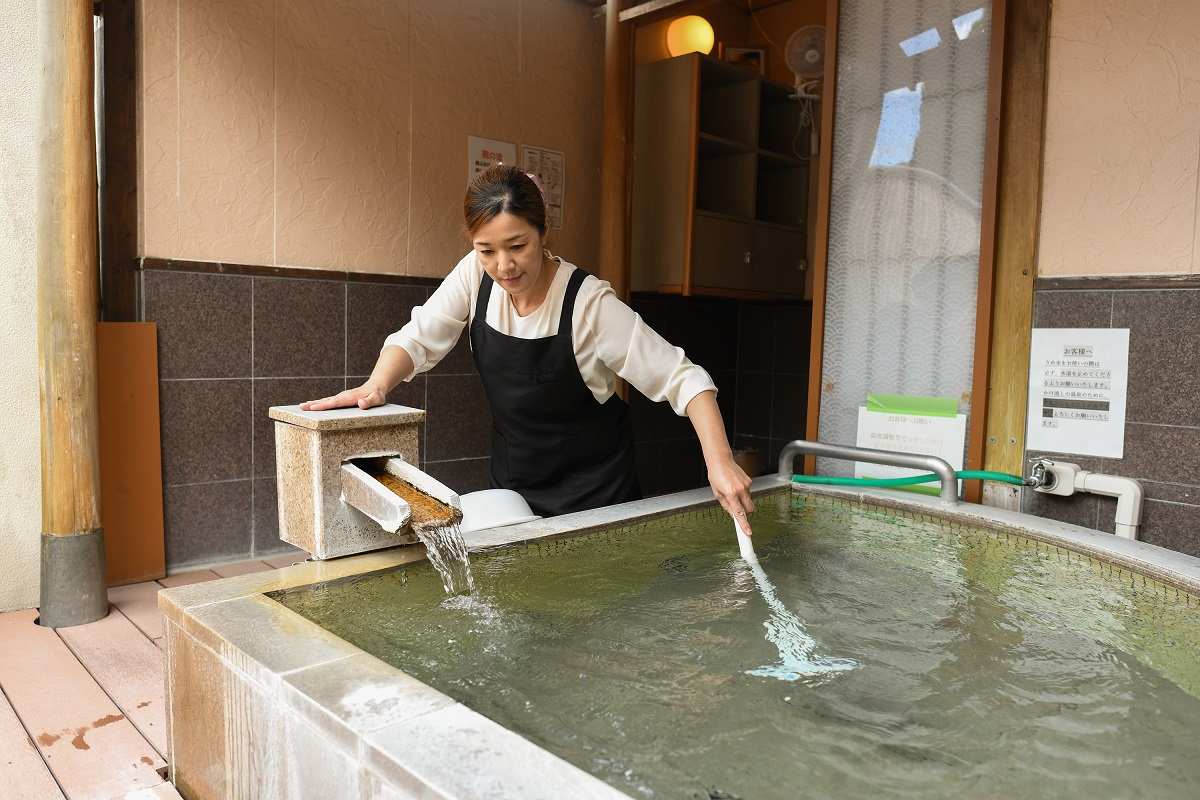
Left: Kiyomi Kuroda, 50, works at shrimp farming near the Tsuchiyu Onsen power station.
Right: Shizue Endo prepares hot spring water at New Ougiya ryokan before guests arrive.
A thousand Tsuchiyus
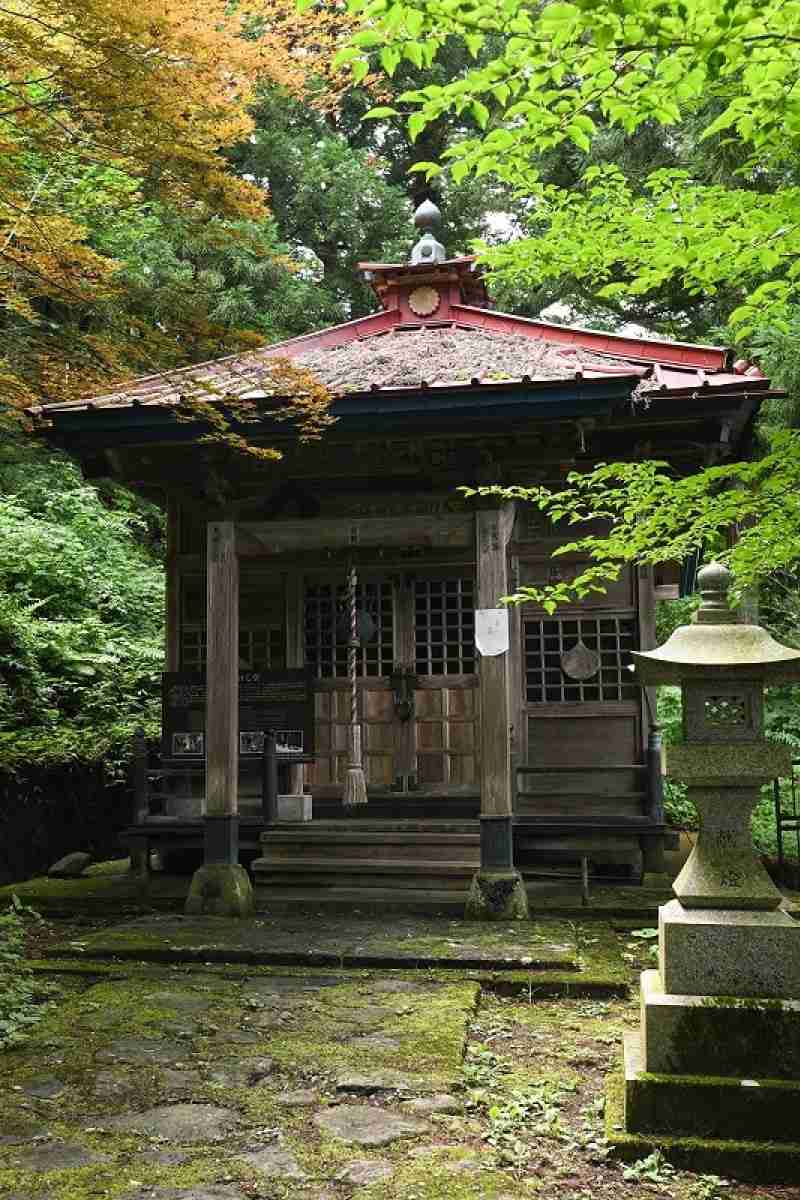
Yakushi Kokeshi Temple is dedicated to the Buddha of healing and medicine located in Shotoku Prince Temple.
Tsuchiyu Onsen could be a model for other onsen towns, according to Tomio Sakuma, renewable energy area manager for Genki Up Tsuchiyu. “It’s very much possible if the local community is onboard,” he said. But he acknowledges it would be harder for onsens that don’t have one centralized source of spring water; in these places, geothermal developers would likely have to drill a new steam source on the outskirts of town, which could invite opposition from onsen owners.
Tsuchiyu Onsen’s geothermal plant uses a relatively new method for making power, which typically uses lower temperature steam and requires less drilling. That means these plants can be built in more places with less risk of disrupting hot springs.
Since 2011, Japan has built more than 70 geothermal generators, nearly all of them like the one in Tsuchiyu Onsen. Only one large-scale plant opened in that time: a 46-megawatt system that produces about 100 times more electricity than Tsuchiyu Onsen’s system. Plans for bigger plants tend to stir up more anxiety from the hot spring industry.
“This spring water is our entire business,” said Endo.
Visitors are likely to notice any change in water quality. True onsen devotees travel from inn to inn to sample the subtle differences in the water in each place.
Chiaki Takaoka, a visitor who lives in a nearby hot spring town called Dake Onsen, says she prefers the water in her hometown. “The smell is different,” she said. “The color of the water is milkier and it makes my skin feel softer and smoother.”
The properties of onsen water are so prized that in 2004, a minor scandal rocked Japan when it was discovered that some onsen inns were using tap water, not hot spring water, in their baths. Others were accused of enhancing their water with bath salts to give it a whiter, milkier color. Several inns shut down in disgrace.
“Japanese people expect so much from onsens and believe in their healing power,” said Mai Kato, deputy director of Tsuchiyu Onsen Tourism Association. “Foreigners might not care, but for Japanese people, it really matters.”
On a recent Thursday afternoon, Tsuchiyu Onsen visitors eased their bodies into the slick, sulfury water that had, moments earlier, billowed out of the earth with enough fury to power hundreds of homes.
But at one of the town’s four public foot baths, there was no sign of the geothermal turbine spinning just a mile away.
Noriko Otsuki, 59, dipped her feet into the water with her 92-year-old father Riichi Fukada. After Fukada’s health began to decline, father and daughter began visiting local onsens. “It’s a good way for us to spend time together,” Otsuki said.
On the other side of the street, 4-year-old Itsuki Takaoka dipped a cautious finger in a foot bath before declaring it too hot to enter. His mother, Chiaki Takaoka, says they visit onsens every two or three days.
“I hope he also falls in love with onsens and we keep this tradition alive,” she said.
"News Services" POPULAR ARTICLE
-

American Playwright Jeremy O. Harris Arrested in Japan on Alleged Drug Smuggling
-

Japan’s Nikkei Stock Average as JGB Yields, Yen Rise on Rate-Hike Bets
-

Japan’s Nikkei Stock Average Licks Wounds after Selloff Sparked by BOJ Hike Bets (UPDATE 1)
-

Japan’s Nikkei Stock Average Buoyed by Stable Yen; SoftBank’s Slide Caps Gains (UPDATE 1)
-

Japanese Bond Yields Zoom, Stocks Slide as Rate Hike Looms
JN ACCESS RANKING
-

Keidanren Chairman Yoshinobu Tsutsui Visits Kashiwazaki-Kariwa Nuclear Power Plant; Inspects New Emergency Safety System
-

Imports of Rare Earths from China Facing Delays, May Be Caused by Deterioration of Japan-China Relations
-

University of Tokyo Professor Discusses Japanese Economic Security in Interview Ahead of Forum
-

Tokyo Economic Security Forum to Hold Inaugural Meeting Amid Tense Global Environment
-

Japan Pulls out of Vietnam Nuclear Project, Complicating Hanoi’s Power Plans





















